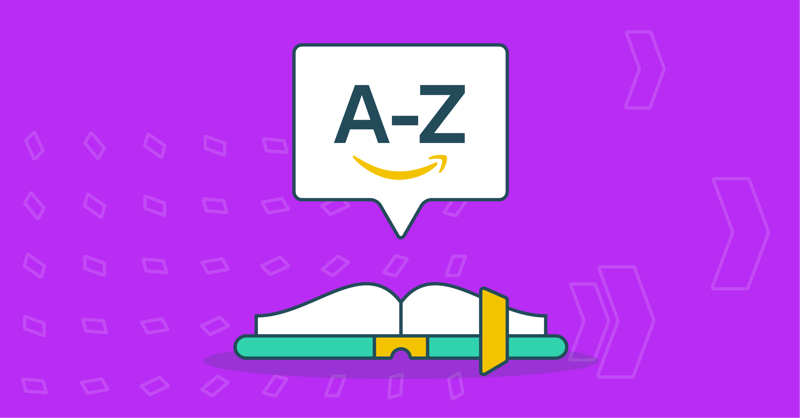
Do you know your IPI score? Are you working on any POAs? Has your marketing team or agency produced any OTTs? Not sure what any of this means? This guide will help.
We know that the Amazon marketplace is full of acronyms and terminology that leave many new and seasoned sellers scratching their heads. Our team put together this glossary to help you identify and understand key Amazon abbreviations and phrases that every seller should know in order to navigate your Seller Central or Vendor Central account, know how to tackle Amazon issues and Seller Support communication, and ultimately see your brand succeed on the marketplace.
Browse through our glossary below, which has been divided into sections based on the key areas that come with selling on Amazon. Be sure to Bookmark this resource for later (since you’ll probably run into a few terms that’ll leave you stumped in the future):
General
- 1P (first-party): selling products wholesale to Amazon via a Vendor Central account, with Amazon managing the brand’s marketplace presence
- 3P (third-party): selling products directly to consumers on the Amazon marketplace via a Seller Central account
- ASIN (Amazon Standard Identification Number): a unique identifier assigned by Amazon that is used for product identification; an ASIN is assigned when you create a new product in Amazon’s catalog
- AWS (Amazon Web Services): a cloud platform offered by Amazon
- Parent & Child ASIN: a standard product (the Parent) and its many variations (the Child)
- SKU (stock keeping unit): a unique identifier used internally for inventory tracking
- UPC (universal product code): a printed code used in product packaging to identify a specific item
Brand Management & Compliance
- Account Health: a dashboard in Seller Central that shows any account issues that need to be resolved, including an overview of your account’s adherence to Amazon’s performance targets and policies
- IP (intellectual property): a creative work or invention unique to your brand in which you hold the rights to (patent, copyright, trademark, etc.). Protect your IP from rogue or unauthorized sellers, combat copyright and trademark infringement, and lower IP risk with Amazon Brand Registry, single-seller relationships, and dedicated monitoring.
- POA (plan of action): an appeal to reinstate selling privileges on Amazon that addresses the cause of the issue, the solution to the issue, and planned steps to prevent future issues
- Product Review: a customer's review of a specific product sold on the marketplace, displayed towards the bottom of a product listing
- RRC (Relative Review Count): The number of reviews you have compared to competitors
- Seller Review: customer feedback about the buying and fulfillment experience, found by clicking on the “Sold by” text on the right-hand side of the page on a product listing
- Seller Support: the area where sellers go to submit a case to Amazon. Find tips for working with Amazon Seller Support
- Suppression: Amazon’s process of hiding, or suspending, a listing, typically based on Amazon’s pricing algorithm. Sellers can also face suppression in the Buy Box, meaning their product is not displayed and additional clicks are required by the customer to purchase, resulting in lower conversation rates.
- Suspension: a seller account put on hold by Amazon due to issues including poor performance, violation of a policy, or an attempt to sell a restricted product
- TOS (Amazon’s Terms of Service): find them here; this is something Amazon updates frequently and every seller should always be up to date on as to not violate TOS and risk account suspension or listing suppression
- Vine: a program in which sellers can pay to submit new or pre-release products for highly trusted Amazon reviewers (called “Vine Voices”) to post unbiased reviews
- VoC (Voice of the Customer): a dashboard in Seller Central that displays customer comments and complaints—which sellers can use to optimize their products and listings
Logistics & Fulfillment
- 3PL (third-party logistics provider): an outsourced partner that handles fulfillment
- A-Z Claim: a guarantee that Amazon offers to customers when they purchase directly from a seller, which covers the product being delivered in a timely manner and in good shape
- BOL (bill of lading): a document that includes a listing of all shipped goods, a receipt for shipped products, and all terms and conditions pertaining to transportation
- Dropshipping: a fulfillment method in which a seller purchases products from a third-party supplier, who then ships the product directly to the customer. In other words, once an order is placed on Amazon, the 3P supplier receives the order and ships it out. Dropshipping is similar to Amazon FBA, but the supplier ships from their own fulfillment center and does not require large amounts of on-hand inventory.
- FBA (Fulfilled by Amazon): a fulfillment method and Amazon program that allows sellers to ship and store their products in bulk to Amazon fulfillment centers, and then Amazon handles all shipping and logistics once an order is placed on the marketplace. FBA products are automatically eligible for Amazon Prime free two-day shipping.
- FBM (Fulfilled by Merchant Network): a fulfillment method in which brands themselves handle all aspects of logistics, shipping, and handling after making a sale on Amazon. This method is the same as MFN.
- FC (fulfillment center): an Amazon warehouse
- FTL (full truckload): a palletized shipment that will reserve the full space in a trailer
- IPI (inventory performance index) score: a key Amazon metric that measures a seller’s efficiency and productivity in managing its FBA inventory
- LTL (less than truckload): a palletized shipment that takes up less than the full space in a trailer
- MFN (Merchant Fulfilled Network): a fulfillment method in which the brand handles all aspects of fulfilling orders that come through Amazon. This method is the same as FBM.
- Prime: a paid Amazon subscription membership that provides shipping discounts, access to Prime Video, and other Amazon services; learn how to become an Amazon Prime seller
- SFP (Seller Fulfilled Prime): a fulfillment method in which a seller that meets Amazon Prime’s quality standards uses Amazon Seller Central and handles storage and shipment in-house. SFP sellers are able to leverage the Prime shipping badge for faster customer conversion.
- Stranded inventory: inventory in a fulfillment center without an active listing on Amazon
Marketing & Advertising
- A+ Content: graphic modules that appear in the product description section on a listing, allowing brands to share their unique story, highlight key features, expand on product specs, and display branding and photography (formerly called Enhanced Brand Content)
- ACoS (advertising cost of sale): ACoS = Ad Spend ÷ Ad Sales, which shows how much of every dollar earned with advertising was spent on an ad campaign; this metric helps to measure the overall success and efficiency of an Amazon Ad campaign
- Amazon Live: an Amazon feature that hosts interactive, shoppable livestreams to showcase products and engage with shoppers
- APS (Amazon Publisher Services): a cloud-based suite of services that makes it possible for web and app publishers to sell ad space on their websites to third-party Amazon sellers
- Brand Registry: an Amazon program available to brands that have a registered trademark to help protect their listings and intellectual property. Amazon Brand Registry also gives sellers access to specific marketing and advertising capabilities.
- Buy Box: the box on the right side of the Amazon product detail page, where customers can add items for purchase to their cart. Amazon designates the Buy Box to the top seller of the product using a proprietary algorithm. Sellers must meet performance-based requirements to be eligible to compete for Buy Box placement, which can lead to increased sales.
- CPC (cost per click): the cost generated each time a visitor clicks on an Amazon Ad
- CX (customer experience): the relationship and interactions between a customer and a brand
- DSP (Amazon’s Demand-Side Platform): a program that gives advertisers the ability to programmatically buy display ad, audio, and video placements both on Amazon and off-platform across the internet
- NCX (negative customer experience) rate: the number of recent Amazon orders with customer-reported issues (returns, refunds, one-star product reviews, etc.) divided by the total number of recent Amazon orders
- OTT (over-the-top video ads): non-clickable, full-screen ads that reach audiences on TV sources, including Amazon Fire TV
- PDP (product detail page): a page hosting a unique product sold on Amazon including a title, product variations, several marketing elements, and customer reviews; also commonly referred to as a product listing. PDPs need regular optimization for success.
- PPC (pay-per-click): an advertising campaign in which advertisers pay a fee each time a visitor clicks on their ad
- ROAS (return on ad spend): ROAS = Sales ÷ Ad Spend; a measure used to gauge the efficiency of an ad campaign. See tips for maximizing your ROAS on Amazon.
- SEO (search engine optimization): the process of optimizing various elements of your Amazon product listing based on organic rank so that you are able to get your product in front of as many customers as possible—this involves keyword targeting and understanding Amazon’s search algorithm
- Storefront: also referred to as an Amazon Store; a branded landing page that enables sellers to create a unique and cohesive shopping experience for their customers. The Storefront displays a brand’s total product offering and tells the brand’s story, as well as serves as a landing page for Amazon advertisements.
- TACoS (total advertising cost of sale): Ad Spend ÷ Total Sales (not just ad sales); the ratio of ad spend to total sales, expressed as a percentage. TACoS gives insight into how ad spend is driving total performance.
- Variation: allows brands to show multiple variations (such as size or color) of the same product to Amazon customers on a single product detail page—allowing shoppers to easily compare and contrast attributes before making a purchase decision
Pricing & Results
- AOV (average order value): the average dollar amount spent each time a customer places an order on your Amazon store
- ASP (average sale price): the average sale price per a given period
- COGS (cost of goods sold): the cost you pay to purchase products directly from a manufacturer in bulk
- CR (conversion rate): the ratio of unique page views on a page to sales made
- KPI (key performance indicator): a performance measurement that represents the success of a brand or a specific category, such as spend, sales, and return on ad spend
- MAP (minimum advertised price): the lowest price at which a seller agrees to have their products sold on Amazon or other ecommerce sites
- ROI (return on investment): comparing how much you paid for an investment on Amazon to how much you earned; used to determine profit/loss
- TV (target velocity): the target number of units to sell per day
Whether you’re feeling apprehensive about selling on Amazon, zen about your current Amazon sales, or anything else from A to Z, we’d love to chat. Connect with us to start a conversation with our team and subscribe to our weekly newsletter to stay on top of key marketplace news, trends, and insights.

